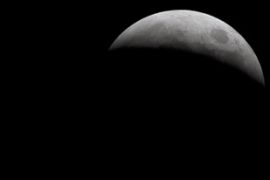Earth watches total lunar eclipse
Earth’s movement makes the Moon turn red in the first total lunar eclipse for three years.

Residents of east Asia saw the eclipse cut short by moonset.
Lunar eclipses occur when Earth passes between the Sun and the Moon, an uncommon event because the Moon spends most of its time either above or below the plane of Earth’s orbit.
|
“It was really very dark. It was quite a nice one” Paul Harper, chairman, Croydon Astronomical Society, UK |
Robert Massey, of Britain‘s Royal Astronomical Society, said: “It’s not an event that has any scientific value, but it’s something everybody can enjoy.”
About a dozen amateur astronomers stood outside the Croydon Observatory in southeast London to watch the eclipse start.
By the time of greatest eclipse, shortly after 2244 GMT, the light of the full Moon was replaced by near-total obscurity.
Paul Harper, chairman of the Croydon Astronomical Society, said: “It was really very dark. It was quite a nice one.”
He estimated that the Moon had lost more than four-fifths of its luminosity.
‘Red planet’
Mike Ealay, an architect, 60, who watched from the Croydon Observatory, said the colour of the moon made it look like a close-up version of Mars.
“I think it’s quite exciting. It’s like having the red planet on your doorstep,” he said.
The Moon’s red blush faded as it began moving out of Earth’s shadow just after 0100 GMT. The eclipse ended a little more than an hour later.
While eastern Australia, Alaska and New Zealand missed Saturday’s show, they will have front row seats to the next total lunar eclipse, on August 28.